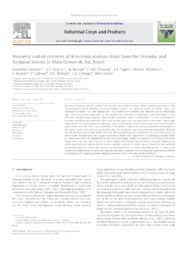Biometry and oil contents of Acrocomia aculeata fruits from the Cerrados and Pantanal biomes in Mato Grosso do Sul, Brazil.
Biometry and oil contents of Acrocomia aculeata fruits from the Cerrados and Pantanal biomes in Mato Grosso do Sul, Brazil.
Author(s): CICONINI, G.; FAVARO, S. P.; ROSCOE, R.; MIRANDA, C. H. B.; TAPETI, C. F.; MIYAHIRA, M. A. M.; BEARARI, L.; GALVANI, F.; BORSATO, A. V.; COLNAGO, L. A.; NAKA, M. H.
Publication year: 2013
Types of publication: Journal article
Unit: Embrapa Instrumentation
Observation
Some of Embrapa's publications are published as ePub files. To read them, use or download one of the following free software options to your computer or mobile device. Android: Google Play Books; IOS: iBooks; Windows and Linux: Calibre.
Access other publications
Access the Agricultural Research Database (BDPA) to consult Embrapa's full library collection and records.
Visit Embrapa Bookstore to purchase books and other publications sold by Embrapa.

